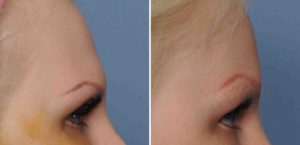A prominent supraorbital or brow bone is known as bossing. While some degree of bossing is acceptable in men, it rarely is so in women. The shape of the lower forehead in men can have a brow bone prominence as evidenced by a brow bone break into the mid-forehead area. In contrast, women desire a smooth transition from the brow area into the forehead which requires no bossing.
While the brow bone looks and feels like solid bone, it is not. The brow bone and its outer shape is determined by the size or aeration of the underlying frontal sinus cavity. This creates a comparatively thin layer of bone over an underlying air space. Reducing frontal bossing, therefore, requires a knowledge of the thickness of the outer bone comprising it to determine how much it can be reduced and what is the best technique to do it.

In the March 2012 issue of the Plastic and Reconstructive Surgery journal, an article was published entitled ‘Endoscopic Correction of Frontal Bossing’. In this paper, the authors performed a retrospective review of 10 patients who had the endoscopic procedure done over a seven year period. The degree of frontal bossing correction was rated as moderate improvement. No violation of the frontal sinus occurred in any patient. The limiting factor in achieving better outcomes was the thickness of the outer table of the brow bone.
Endoscopic reduction of the prominent brow bone requires two things; proper endoscopic instrumentation and frontal bossing that has thick enough bone. Adequate bone thickness has to be at least 5mms in thickness as determined by a lateral skull x-ray. A 1 or 2mm reduction is not going to make a noticeable difference. But a 3 to 4mm reduction will make a discernible reduction in the amount of frontal bossing. This determination can be done beforehand by tracing out the frontal bossing outline and seeing how the soft tissue profile changes as the bone is thinned.
Endoscopic reduction of the prominent brow bone is a safe and effective procedure. Its use, however, is restricted to a very few patients whose brow bone thickness allows visible improvement with a burring technique.
Dr. Barry Eppley
Indianapolis, Indiana


